The Army Class B uniform balances practicality and professionalism, serving as a versatile attire for daily duties and formal events․ It embodies military tradition, discipline, and pride, requiring precise setup and adherence to grooming standards to maintain its esteemed appearance and functionality․
Overview of the Class B Uniform
The Army Class B uniform is a cornerstone of military appearance and functionality, serving as a versatile attire for both daily duties and formal events․ It represents a balance between aesthetics and practicality, ensuring soldiers present a professional image while maintaining comfort․ This uniform is designed to uphold the Army’s tradition of discipline and pride, requiring meticulous attention to detail in its setup and maintenance․ It is a symbol of military identity, reflecting the values of service, respect, and unity․ Proper wear of the Class B uniform demonstrates adherence to established standards, fostering a sense of cohesion and professionalism within the ranks․
Historical Background of the Class B Uniform
The Class B uniform has its roots in the early 20th century, evolving from various iterations of military attire to meet changing needs․ Initially designed for field operations, it gradually transitioned to a more formal role, reflecting the Army’s shift toward modernization․ Over the years, modifications such as fabric improvements, updated tailoring, and the addition of insignia have been made to enhance functionality and appearance․ This uniform has played a significant role in maintaining the Army’s professional image, with its design influenced by historical events and the necessity for practicality․ Its legacy continues to be upheld through precise grooming and setup standards․
Components of the Class B Uniform
The Class B uniform consists of a shirt, trousers, belt, footwear, socks, and accessories like ties and rank insignia, designed for practicality and professionalism in daily duty settings․
The Class B Shirt: Fabric, Color, and Fit
The Class B shirt is typically made from a durable, wrinkle-resistant fabric, often in a light shade to maintain professionalism․ The color is standardized to ensure uniformity across all ranks․ Proper fit is crucial, with the shirt tailored to be slightly tapered at the waist for a sharp appearance․ Sleeves should be long enough to cover the mid-forearm when the arm is bent, and the collar must fit snugly without being constricting․ Attention to detail ensures the shirt aligns with the Army’s grooming and appearance standards, reflecting discipline and readiness for duty․ Fabric quality is selected for both comfort and longevity․
Class B Trousers: Style, Fabric, and Tailoring
Class B trousers are crafted from durable, wrinkle-resistant fabrics such as wool or polyester blends, ensuring longevity and a professional appearance․ The style typically features a straight leg with a slight crease down the center, designed for a neat and polished look․ The color is standardized to match the Class B shirt, maintaining uniformity․ Tailoring is essential, with the trousers fitting snugly around the waist and breaking just above the shoes․ Proper alterations ensure the fabric lies smoothly, avoiding sagging or excessive tightness․ Attention to these details ensures the trousers complement the overall uniform, reflecting the Army’s standards of discipline and precision․
The Class B Belt and Buckle
The Class B belt and buckle are essential components, serving both functional and aesthetic purposes․ The belt is typically made from high-quality leather, ensuring durability and a polished appearance․ It is worn snugly around the natural waistline, secured with a standardized buckle that aligns with Army regulations․ The buckle often features the Army insignia or a subdued design, maintaining a professional look․ Properly threading the belt through the trousers ensures a neat and uniform appearance․ The belt and buckle collectively contribute to the overall sharpness of the Class B uniform, symbolizing discipline and adherence to military standards․
Footwear: Shoes and Boots Approved for Class B
Footwear for the Class B uniform must meet strict Army standards, ensuring both functionality and a polished appearance․ Oxfords or leather dress shoes are typically authorized, featuring a smooth, black leather finish with a low to moderate heel․ Boots, such as the Army Combat Boot, may also be worn, provided they are clean and polished․ The footwear must complement the uniform’s professional look, with no visible logos or decorative elements․ Properly shined and maintained footwear enhances the overall neatness of the uniform, reflecting discipline and adherence to military grooming and presentation standards․ Comfort and durability are also key for daily wear․
Socks and Undergarments
Socks and undergarments play a crucial role in the comfort and professionalism of the Class B uniform․ Socks must be plain, black, and made of moisture-wicking fabric to prevent odor and maintain a neat appearance․ They should be of appropriate thickness to avoid bunching or sagging․ Undergarments must be simple, neutral-colored, and not visible beneath the uniform․ Both socks and undergarments should be made of breathable materials to prevent chafing and irritation during extended wear․ Proper selection ensures comfort while adhering to the uniform’s aesthetic standards, contributing to a polished and professional look․ Attention to these details is essential for maintaining military grooming standards․
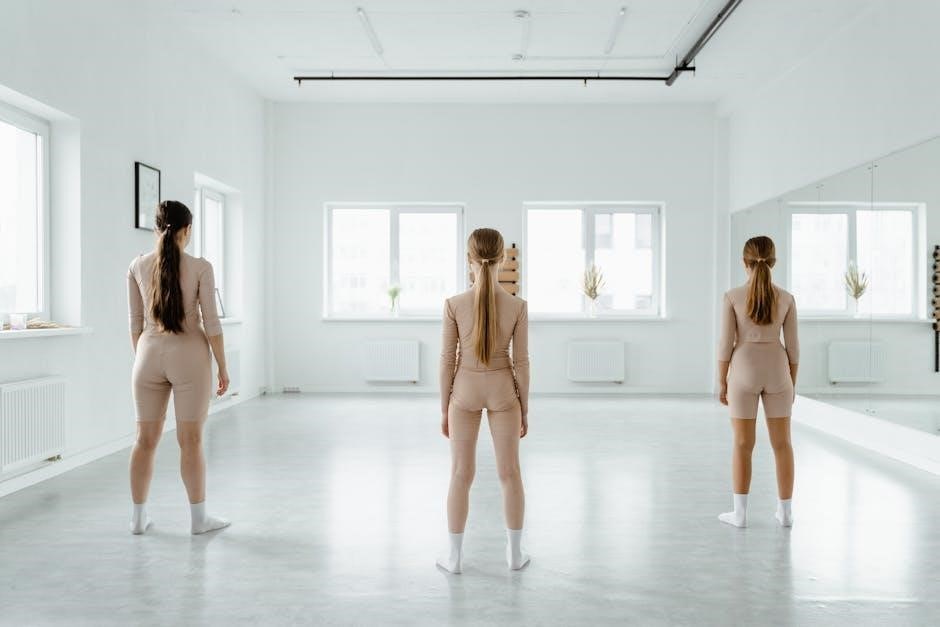
Accessories for the Class B Uniform
Accessories like ties, rank insignia, service ribbons, and badges enhance the uniform’s professionalism while adhering to strict military guidelines, ensuring a polished and cohesive appearance․
Ties and Neckwear
Ties and neckwear are essential components of the Class B uniform, enhancing its formal appearance․ Enlisted personnel must wear a necktie in either a four-in-hand or half-Windsor knot․ The tie should match the uniform’s color palette, typically black or Army green, and feature a subtle pattern․ It must be made of silk or a similar material, ensuring a polished look․ The tie bar or clasp is optional but recommended to secure the tie neatly․ Properly tying and maintaining the neckwear reflects attention to detail and professionalism, aligning with the Army’s standards of discipline and presentation․
Rank Insignia Placement
Rank insignia placement on the Class B uniform is crucial for proper identification and respect for hierarchy․ Enlisted ranks are displayed on the shirt’s sleeves, centered between the shoulder seam and the elbow․ The rank is positioned one inch below the shoulder seam on the left sleeve for non-commissioned officers (NCOs)․ Specialist and corporal ranks are worn one and a half inches below the shoulder seam․ Ensure the insignia is securely fastened and aligned horizontally․ Correct placement reflects professionalism and adherence to military standards, maintaining uniformity across all personnel․ Properly displaying rank insignia is essential for visual identification and unit cohesion․
Service Ribbons and Medals
Service ribbons and medals are worn on the left side of the Class B uniform shirt, centered above the pocket․ Ribbons are placed in rows of three, aligned horizontally, with the highest precedence ribbon on the left․ Medals are centered below the ribbons, also following precedence rules․ Ensure all awards are securely fastened and evenly spaced․ The number of rows is limited to prevent overcrowding․ Proper alignment and placement reflect attention to detail and respect for military traditions․ Always refer to AR 670-1 for specific guidance on precedence and arrangement to maintain uniformity and professionalism․
Badges and Patches
Badges and patches on the Class B uniform are worn to denote achievements, qualifications, and unit affiliation․ Nameplates are centered above the right pocket, while rank insignia is placed on the left side․ Skill badges, such as combat or special skill badges, are worn above the left pocket, aligned with the nameplate․ Unit patches are placed on the left sleeve, and the U․S․ Army insignia is worn on the right sleeve․ Ensure all badges and patches are securely attached and follow AR 670-1 guidelines for proper placement and precedence to maintain a professional appearance․
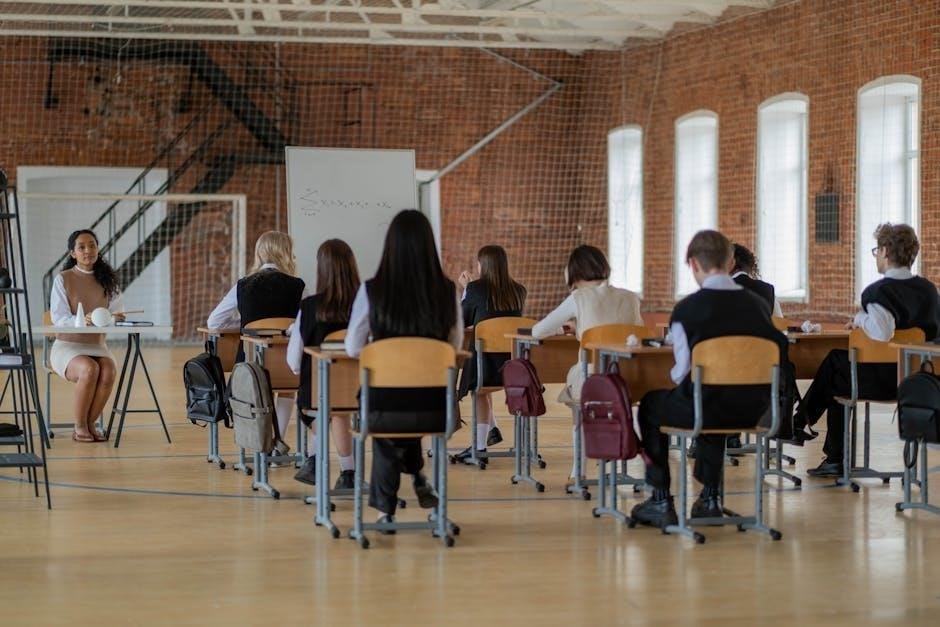
Proper Fit and Alterations
Proper fit and alterations are crucial․ Achieving the proper fit ensures comfort and professionalism․ Tailoring enhances the uniform’s appearance without compromising functionality, adhering to AR 670-1 guidelines accurately․
How to Achieve the Perfect Fit
Achieving the perfect fit involves precise measurements and tailoring․ Ensure the shirt fits snugly, with sleeves ending at the wristbone․ Trousers should break slightly above the shoes, with a streamlined fit through the thigh and knee․ The belt must cinch naturally at the waistline without sagging․ Pay attention to shoulder alignment, ensuring the seams sit flush with the body․ Alterations should maintain functionality while enhancing appearance, following AR 670-1 guidelines․ Proper fit reflects professionalism and adherence to military standards, essential for the Class B uniform’s purpose and presentation․
Guidelines for Tailoring and Alterations
Tailoring the Class B uniform requires precision to maintain its professional appearance while ensuring functionality․ Alterations should adhere to AR 670-1 guidelines, preserving the uniform’s integrity․ Measurements must be accurate, focusing on a snug yet comfortable fit․ Sleeves and trouser legs should be tailored to avoid excessive fabric without compromising mobility․ Authorized alterations include hemming pants, adjusting waistbands, and tapering sleeves․ Ensure all modifications maintain the uniform’s original design intent․ Avoid over-alteration, as it may render the uniform unserviceable․ Professional tailors familiar with military standards are recommended to ensure compliance and a polished finish․
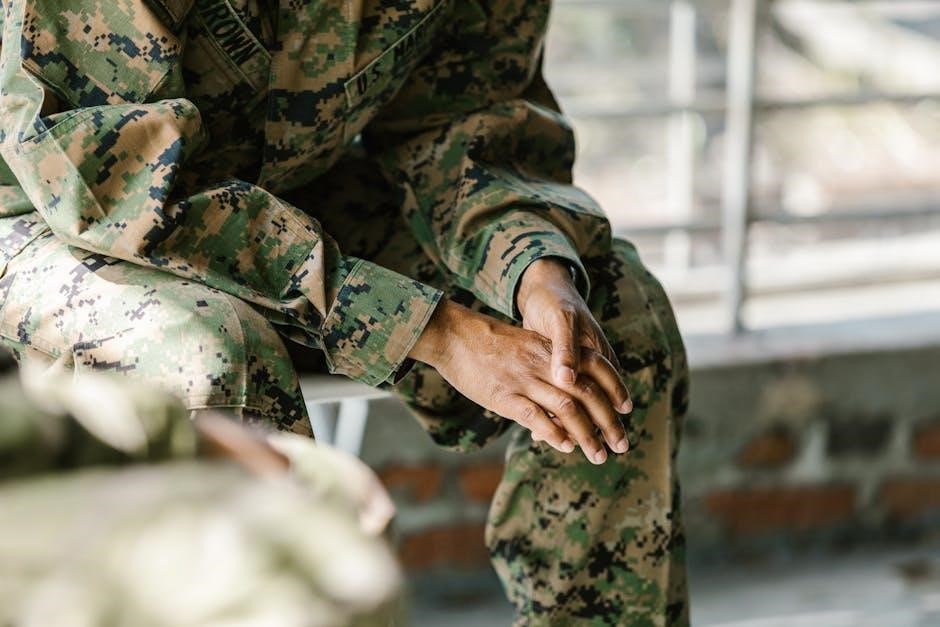
Grooming Standards
Grooming standards ensure a neat, professional appearance․ Haircuts must be regulation-length, sideburns trimmed, and facial hair shaved or neatly trimmed․ Nails should be clean and appropriately trimmed․
Haircut Regulations
Haircut regulations for the Army Class B uniform emphasize neatness and professionalism․ Hair must be kept at a moderate length, with no extremes in style or length․ Sideburns are allowed but must be trimmed to align with the earlobes and not extend below the bottom of the ear․ The hair on the top of the head should be styled neatly, avoiding any exaggerated or faddish styles․ Additionally, Mohawks, shaved designs, and excessive layering are prohibited․ Soldiers are expected to maintain a clean, trimmed appearance, ensuring their haircut complements the uniform and upholds military standards․ Proper grooming reflects discipline and adherence to Army traditions․
Facial Hair and Shaving Standards
The Army requires soldiers to maintain a clean, neat appearance, with strict standards for facial hair․ Beards are generally not permitted, and soldiers must be clean-shaven while wearing the Class B uniform․ Sideburns should be trimmed to align with the earlobes and not extend below the bottom of the ear․ Mustaches are allowed but must be neatly trimmed and not extend beyond the corners of the mouth․ Any facial hair must complement the uniform and not detract from its professional appearance․ These standards ensure a polished look, consistent with military tradition and discipline, while allowing for personal grooming within defined limits․
Nail Care and Personal Hygiene
Nail care and personal hygiene are critical components of the Class B uniform standards․ Fingernails must be clean, trimmed short, and free of polish or artificial enhancements; Toenails should also be well-groomed and maintained to prevent dirt buildup․ Soldiers are expected to practice good personal hygiene, ensuring hands, face, and body are clean․ Hair must be neatly styled and free of excessive oils or products․ These standards ensure a professional and disciplined appearance, reflecting the Army’s emphasis on order and cleanliness․ Proper hygiene also supports health and readiness, aligning with the uniform’s purpose of presenting a sharp, cohesive image․
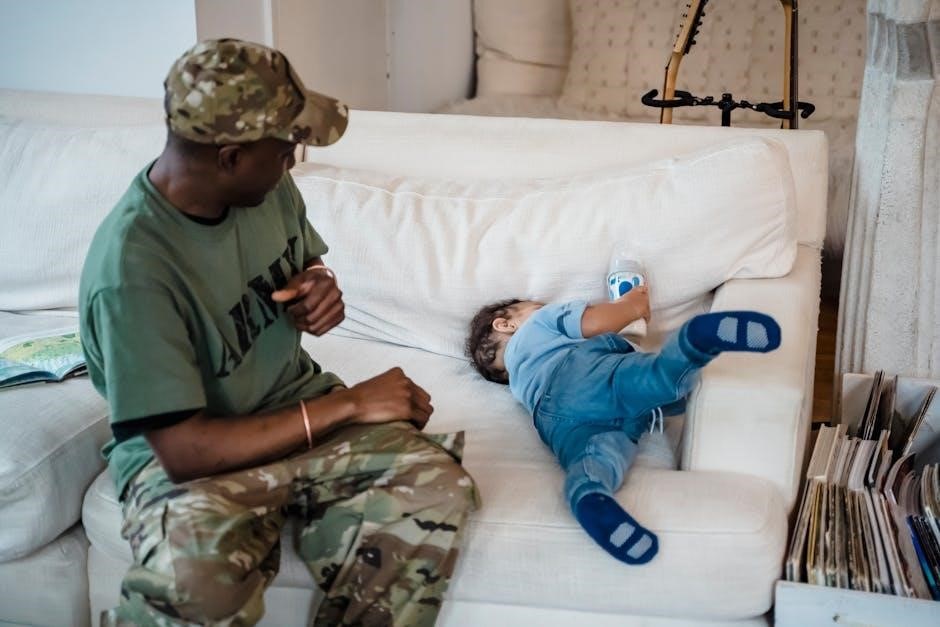
Putting It All Together
Assembling the Class B uniform requires attention to detail, ensuring all components align seamlessly․ Properly integrate the shirt, trousers, belt, footwear, and accessories for a polished, professional appearance that reflects Army standards and discipline․
Step-by-Step Assembly of the Uniform
Begin by putting on the Class B shirt, ensuring it is properly buttoned and aligned․ Next, slip on the trousers, adjusting the waist for a snug fit․ Secure the belt with the authorized buckle, positioning it at the center of the waistline․ Put on your polished footwear, ensuring it is clean and matches the uniform’s color scheme․ Add socks, making sure they are visible and meet Army standards․ Finally, attach all required accessories, such as rank insignia, badges, and service ribbons, in their designated positions․ Complete the look by tying the necktie correctly and conducting a final inspection for proper alignment and appearance․
Final Checks and Inspections
Before completing the uniform setup, conduct a thorough inspection to ensure all components are correctly assembled and meet Army standards․ Check that the shirt is properly tucked, trousers are aligned, and the belt is centered․ Verify that all rank insignia, badges, and service ribbons are accurately positioned and secured․ Inspect footwear for cleanliness and proper polish․ Ensure socks are visible and comply with regulations․ Use a mirror to confirm the tie is correctly knotted and centered․ Finally, have a fellow soldier or supervisor review the uniform for any overlooked details, ensuring a polished and professional appearance that reflects military pride and discipline․
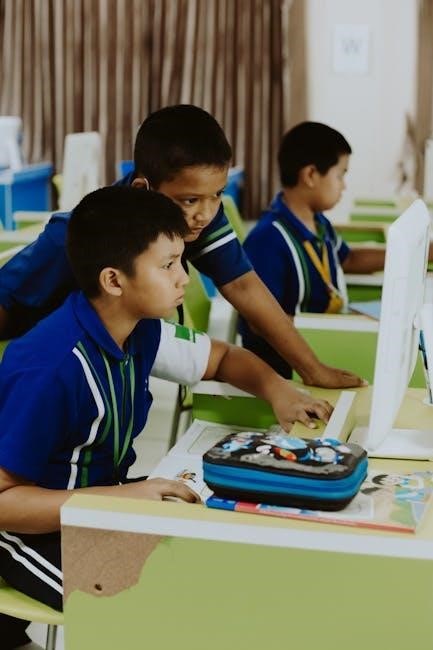
Occasions for Wearing the Class B Uniform
The Class B uniform is appropriate for daily duty, routine activities, and formal events such as ceremonies, parades, and official meetings, ensuring a professional military presence․
Daily Duty and Routine Activities
The Class B uniform is primarily worn for daily duty and routine activities, offering a professional yet comfortable option for soldiers․ It is suitable for office environments, training sessions, and non-combat field exercises․ The uniform’s design allows for ease of movement while maintaining a polished appearance․ Soldiers are expected to maintain high grooming standards, ensuring their attire is clean, pressed, and properly fitted․ This uniform is a staple in daily military operations, reflecting discipline and readiness․ Proper wear includes all authorized components, such as the Class B shirt, trousers, belt, and footwear, all of which must meet specific regulations․
Formal Events and Ceremonies
The Class B uniform is also worn during formal events and ceremonies, where a higher level of presentation is required․ For such occasions, soldiers ensure their uniform is immaculately pressed, with all components perfectly aligned․ Additional accessories like ties, service ribbons, and medals may be added to enhance the uniform’s formality․ Proper grooming standards are strictly enforced, with attention to haircuts, facial hair, and nail care․ The uniform’s polished appearance reflects the Army’s tradition and professionalism, making it suitable for parades, award ceremonies, and other official functions․ It serves as a representation of discipline and pride during these significant events․
Maintenance and Care
Regular cleaning, pressing, and proper storage are essential to maintain the Class B uniform’s quality and appearance․ Follow specific care instructions to ensure longevity and professionalism․
Cleaning and Pressing Tips
Proper cleaning and pressing are crucial for maintaining the Class B uniform․ Use mild detergents for fabrics, avoiding harsh chemicals․ Iron shirts and trousers while slightly damp to prevent wrinkles․ Ensure all creases align with uniform standards․ Regular steaming can refresh the uniform without damaging materials․ Store cleaned items in a cool, dry place to prevent moisture buildup․ Always follow care labels for specific fabric types to maintain the uniform’s integrity and extend its lifespan․
Storage and Preservation
Store the Class B uniform in a cool, dry place to prevent moisture buildup․ Use acid-free tissue paper to stuff shirts and trousers to maintain shape and prevent wrinkles․ Hang uniforms on padded hangers to avoid stretching․ Avoid direct sunlight to prevent fading․ Use breathable garment bags instead of plastic to reduce mildew risk․ Ensure all components are clean and dry before storage to prevent odors․ Avoid storing in cardboard boxes, as they can retain moisture․ Regularly inspect stored items for signs of wear or damage․ Proper storage ensures the uniform remains crisp and professional for future use․
Common Mistakes to Avoid
Avoid improper fit, sagging fabrics, and misplaced insignia․ Ensure uniforms are clean and pressed, with correct alignment of rank and service ribbons․ Prevent loose threads and missing buttons․
Incorrect Placement of Insignia
Incorrect placement of insignia is a common mistake that can undermine the professionalism of the Class B uniform․ Rank insignia must be centered on the shirt and aligned with the nameplate․ Service ribbons should be placed in the designated area above the left breast pocket, ensuring they are properly spaced and ordered by precedence․ Badges and patches must adhere to specific regulations regarding size, color, and positioning․ Improper alignment or missing insignia can lead to disciplinary action, emphasizing the importance of careful adherence to guidelines during uniform assembly and inspection․
Improper Fit and Sagging Fabrics
Improper fit and sagging fabrics can compromise the sharp, professional appearance of the Class B uniform․ Baggy shirts or pants detract from the military image, while tight clothing restricts movement․ Sagging fabrics, such as an ill-fitting belt or loose trouser legs, create a disheveled look․ Ensuring a tailored fit is essential, as it reflects discipline and attention to detail․ Regular inspections and alterations can prevent these issues, maintaining the uniform’s integrity and the soldier’s professional demeanor․ Properly fitted uniforms not only enhance individual appearance but also uphold unit standards and military tradition․
